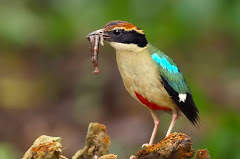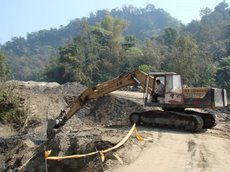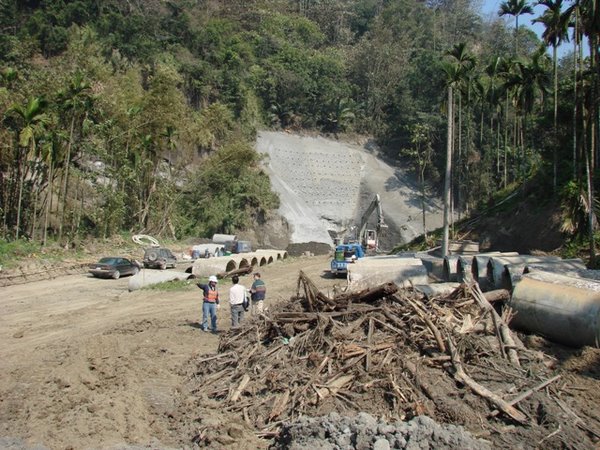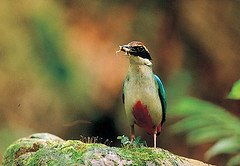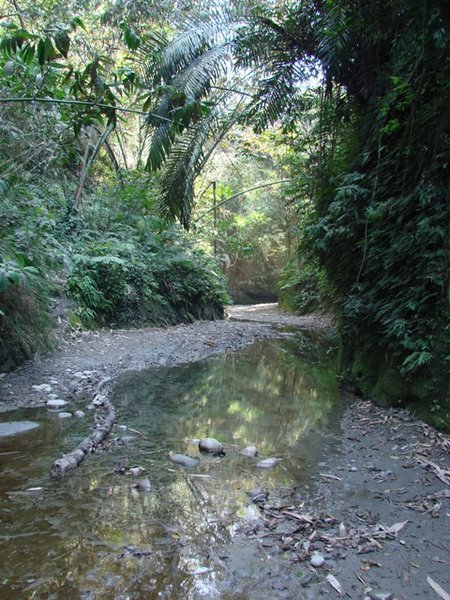 A Huben Fairy Pitta (Pitta nympha): photo courtesy of Richard Yu.
A Huben Fairy Pitta (Pitta nympha): photo courtesy of Richard Yu.
Happy New Year and all the best for 2010 !
"Because every green measure, every conservation effort and all the little economies we could make in our daily lives, may look insignificant if we choose to look at the big picture. On the other hand, if we view that big picture as millions of little choices made by people just like us, that's how we can come to understand why it's our own choices that are so important."
A comment posted on Birdforum by James Owen.
Thursday, December 31, 2009
Happy New Year !
Posted by
Wild at Heart Legal Defense Association
at
3:31 PM
0
comments
![]()
Tuesday, December 29, 2009
FTV report on high levels of cancer in Mailiao and Taisi Townships in Yunlin County
What follows is an English translation from part 2 of a series that Formosa TV (FTV) has done on the high cancer rate from the areas surrounding the Formosa Petrochemicals’ No.6 Naphtha Cracker plant at Mailiao on the Yunlin County coast in central Taiwan.
As planned expansion of heavy industry in this area goes ahead it will no doubt cause an increase in these cancer rates as emission levels increase dramatically. The government is forging ahead with its so-called development plans. In November the Taiwan Environmental Protection Administration gave the green light to the planned Erlin Science Park just over the county border in Changhua county. Demands for water for heavy industry will be supplied by the infamous Hushan Reservoir project. It would seem that the health of the citizens of central Taiwan, both human and non human, come a very poor second when it comes to keeping heavy industry happy. Spare a thought for the Fairy Pitta and Taiwan White Dolphins in all this mess.
Naphtha cracking plant linked to high cancer rate in central Taiwan towns (2009/12/27)
The central Taiwan townships of Mailiao and Taishee have had the highest liver cancer death rates of any area in Taiwan for years. Nearby is Taiwan’s largest naphtha cracking plant. The Yunlin County government commissioned an NTU professor to conduct research on the health risks posed to the residents of areas around the plant. Tonight, in part 2 of a continuing series, we take a closer look at the research report.
This thick research report helped open the scientific discussion related to Formosa Petrochemicals’ No. 6 Naphtha Cracker and local residents’ health. National Taiwan University Professor Jhan Jhang-cyuan spent one year gathering information from the five neighboring townships of Mailiao, Lunbei, Taishee, Dongshih and Shihu. The report was commissioned by the Yunlin County government. It compiled information from the Department of Health, Ministry of the Interior and Bureau of National Health Insurance. The results showed an important discovery.
Jhan Jhang-cyuan
National Taiwan University
If you look at the death rates from malignant tumors and lung cancer in Taishee Township from the fourth to the sixth year of operations, they’re obviously higher than the first three years. So the longer operations have been going on, the higher the rate of cancers in Taishee Township, particularly lung cancer. The rate of liver cancer in Taishee and Mailiao townships both before and during the operation period is higher than other townships we looked at. So it’s correct to say that the rates of liver and other types of cancers are high in Yunlin County, but since the No. 6 Naphtha Cracker they’ve become even higher.
The petrochemicals industry possesses many cancer-causing agents. Among them is vinyl chloride monomer, which is a raw material for plastic and has been connected to liver cancer. The oil refining process produces byproducts such as benzene and acetic acid that have been shown to be related to leukemia.
Petrochemical plants often emit polycyclic aromatic hydrocarbons, which are known to be closely associated with lung cancer. Professor Jhan also examined air quality reports from the Environmental Protection Administration and data from the Bureau of National Health Insurance. He discovered that more people were hospitalized for breathing difficulties when emission levels of nitrogen oxide, sulfur dioxide and other similar gases were high. There were also more deaths.
Jhan Jhang-cyuan
National Taiwan University
Monitoring was performed every hour of every day for two years. The data was then applied to Taishee. It obviously showed that when the wind blew from between the northwest and northeast, (gas) concentrations would become very high. They could increase from 20 to 30 times or more above average.
These scientific discoveries were completely in line with the experience of local residents. When the wind blew or the rain fell, their crops would suffer.
Mr. Chen
Erlun Township Farmer
These (melons) can’t be harvested. It only needs to rain once and they will turn yellow and start to rot. These melons won’t grow large, all of them here. It just needs to rain once and the pollution will kill them.
Crops like chrysanthemums will also begin to rot immediately after rainfall. The destruction of crops can be made up for by compensation payments, but human beings are a different matter. Although Erlun Township was not included in Jhan’s report, many of the same health issues are occurring there.
Erlun Township Resident
It might be factors such as the air or water, but we don’t have professional knowledge. If we blame the No. 6 Naphtha Cracker, they will tell us to bring forward our evidence.
Reporters who seek the company’s side of the story always have trouble receiving a direct answer.
Voice of Formosa Petrochemicals PR Rep.
Generally speaking, (there are many causes of cancer). For example, even if you live in mountains where the air is very good, some people still get cancer. We don’t know why.
Just when our investigation had seemed to reach an impasse, we acquired a copy of a survey from 2005 performed by the Industrial Development Bureau. The survey focused on the No. 6 Naphtha Cracker and the health risks of local residents. The report was marked “Restricted Reading.” It turned out that the bureau possessed relevant assessment reports years ago, but never made the results public. In our next installment we will take a look at the secrets inside the bureau’s report.
Source: http://englishnews.ftv.com.tw/read.aspx?sno=C585E7E31DEF7010ACF37A7BE56126CD
Posted by
Wild at Heart Legal Defense Association
at
3:19 PM
0
comments
![]()
Friday, December 11, 2009
Snowy-browed Flycatcher: New Bird for the Huben-Hushan IBA Bird List

 Male Snowy-browed Flycatcher (Ficedula hyperythra): Photos courtesy of Richard Yu.
Male Snowy-browed Flycatcher (Ficedula hyperythra): Photos courtesy of Richard Yu.
On Saturday 5TH December 2009 birders Mark Wilkie and Dr. Bruno Walther spotted a male Snowy-browed Flycatcher Ficedula hyperythra innexain the forest around Huben village. This is the first record of a Snowy-browed Flycatcher in the Huben-Hushan Important Bird Area (IBA). Snowy-browed Flycatcher is a resident species on Taiwan and usually found in mid to upper elevation forests (1000-2300m) but can sometimes be found at lower altitudes during winter. Race innexa is endemic to Taiwan.
Huben-Hushan Bird List
Posted by
Wild at Heart Legal Defense Association
at
11:37 AM
0
comments
![]()
Monday, November 30, 2009
County Elections: The lack of 'green' candidates


It's almost midnight in Taiwan and tomorrow's on-line edition of the Taipei Times is up. An article titled Vote for 'green' candidates, activists say caught my attention.
On Saturday 5Th December, county elections will take place for the election of city mayors and county commissioners and for the past few weeks, all across Taiwan, we've been subjected to the deafening racket of campaigning 'a la Taiwan' style.
Campaigning in Taiwan involves fleets of noisy election vans roaming the streets broadcasting their candidate's propaganda at ear-shattering volumes that are well in excess of noise pollution laws. Often candidates will stand on a rickety platform atop a van screaming into a microphone and subjecting all and sundry to their views of the world, the alleged shortcomings and vices of their opposition, and strings of promises of what they will do if elected.
The candidate's van is usually followed by several other vans and cars. The other vans will be broadcasting prerecorded political propaganda while the candidate is still screaming into the microphone. While this is going on, folks perched atop another van will be letting off firecrackers. Sometimes gongs, drums and flutes accompany the din of the firecrackers. Bear in mind that this often goes on late into the night and resumes first thing in the morning. Several different motorcades launch simultaneous attacks on the same areas resulting in the most unbelievable noise levels and disruptions to the flow of traffic. These motorcades are followed by legions of campaign workers that chant and cheer while accosting locals and thrusting little packets of tissues and pamphlets into the hands of anyone they can lay their hands on. Enthusiastic campaign workers are not above entering any shop or house that has an open door. Often the cheering campaign workers are supported by a speaker van broadcasting the cheers of a prerecorded crowd. Also, every available lamppost, pole and wall are covered in election posters, banners and flags.
Most people one speaks to loath the noise of elections but would never consider banding together and trying to do something about it. This so often is the case in Taiwan. The people just shut up and don't speak out. People are angry about the noise. They are angry about pollution. They are angry about corruption and mismanagement but they tolerate it all. They never appose the system. Is this the legacy of almost forty years of Marshal law and the product of an education system that discourages individual thinking and the questioning of authority?
Taiwan has a tragic legacy of greedy and corrupt politicians that lack moral accountability and responsibility. Global warming and combating the effects of climate change feature highly on the political agenda in most parts of the free world now. Taiwan's lack of commitment to sustainable economics and the reduction of emissions is in direct contrast to that of most other democratic free nations. This lack of commitment to doing anything about the environment and sustainable economics is evident in the lack of any stand on these issues for almost all candidates. In the present legislature many feel there is only one legislator that has any credible track record of really standing up for the environment. Reality on the ground in Taiwan is that the politicians feel no pressure at all to have to start considering the environment and sustainable economics and until they do, nothing is going to change.
Posted by
Wild at Heart Legal Defense Association
at
11:17 PM
0
comments
![]()
Tuesday, November 10, 2009
Kentish Plover


The Kentish Plover Charadrius alexandrinus is a common wintering bird in the coastal regions of Taiwan. Kentish Plover have been recorded in the Huben-Hushan area during winter but their presence is accidental.
Huben-Hushan Bird List
Posted by
Wild at Heart Legal Defense Association
at
12:26 PM
1 comments
![]()
Saturday, October 31, 2009
Oriental Pratincole

The Oriental Pratincole Glareola maldivarum is a rare summer visitor to the Huben-Hushan area. Oriental Pratincole is fairly common along Taiwan's western coastal plain during the summer. While it is rare in the Huben-Hushan area it is a common sight along the nearby Jhoushuei River during the summer.
Huben-Hushan Bird List
Posted by
Wild at Heart Legal Defense Association
at
10:28 AM
0
comments
![]()
Friday, October 16, 2009
Daurian Redstart

An uncommon wintering species found in the fields and scrub in the Huben-Hushan area is the Daurian Redstart Phoenicurus auroreus.
Huben-Hushan Bird List
Posted by
Wild at Heart Legal Defense Association
at
2:47 PM
0
comments
![]()
Friday, October 9, 2009
Black-winged Stilt

Though not listed on the official Huben-Hushan Bird List, Black-winged Stilt Himantopus himantopus, are often seen in flooded rice fields during spring, autumn and winter in the surrounding farm areas close to the village of Huben. Perhaps this bird should be added to the list. It is something that we'll look into.
Huben-Hushan Bird List
Posted by
Wild at Heart Legal Defense Association
at
12:55 PM
0
comments
![]()
Monday, October 5, 2009
Yellow Bittern

The Yellow Bittern Ixobrychus sinensis [aka Chinese Bittern] is a
rather secretive rare resident waterbird in the Huben-Hushan area that can be seen in the reed beds and undergrowth along streams.
Huben Bird List
Posted by
Wild at Heart Legal Defense Association
at
12:51 PM
0
comments
![]()
Saturday, October 3, 2009
Taiwan's Aborigines Suffer More Than Morakot

"An additional alliance that aborigines of all tribes must forge is that with the environmentalists in Taiwan, both in politics and life. This is a natural alliance since all want to preserve and protect the ancestral lands of Taiwan."
Some interesting comment and insight in the wake of Typhoon Morakot concerning Taiwan's indigenous peoples and the natural environment by Taipei-based writer, educator and historian, Jerry Keating.
Taiwan's Aborigines Suffer More Than Morakot
Friday October 02, by Jerome F. Keating Ph.D.
Typhoon Morakot did more than expose the incompetence and lack of leadership in the Ma administration; it highlighted another salient issue in Taiwan, the plight of its aboriginal people. Like many indigenous people suffering the fates of past colonialism, these people are pulled in opposite directions. Tugging on the one side is the wish to maintain their traditional life styles and identities; on the other side are the demands for survival and dignity in the modern, fast-paced, high-tech society surrounding them. As a result, they are being marginalized to the point of extinction. Even if they do fit in, at best, they often face the life of second class citizens teetering on the brink of welfare. If ever the aboriginal community needed vision and leadership, it is now.
Where to find it? The sight of aboriginal villages washed away and wiped out after Morakot has been horrendous; worse, however, is the realization that the causes were more than the typhoon. The devastation came as the result of lack of strong environmental policies and how mountainsides denuded of trees are unable to stop mudflow. Worse still is the fact that the decisions on deforestation and vulnerability were made by profiteers and forces outside the sphere of influence of the villagers.
To read the complete article visit Jerry Keating's website by clicking here.
Also see:
The proof of the pudding is in the eating: The Chingshuei River after Morakot (includes photos).
Typhoon Morakot: The Writing's on the Wall
Air quality worsens from Typhoon Morakot's dust
Posted by
Wild at Heart Legal Defense Association
at
11:19 AM
0
comments
![]()
Tuesday, September 29, 2009
White-breasted Waterhen

The White-breasted Waterhen Amaurornis phoenicurus is a fairly common waterbird frequenting the reed beds and undergrowth along streams in the area. At dawn and dusk one can often observe them feeding along the edges of the stream and on sand bars in the stream which runs through Huben village.
Huben Bird List
Posted by
Wild at Heart Legal Defense Association
at
12:15 PM
0
comments
![]()
Monday, September 14, 2009
The proof of the pudding is in the eating: The Chingshuei River after Morakot
One of the major criticisms and concerns over the Hushan Dam project is that the dam will just silt up and become unusable within a very short period. After the devastating earthquake in September 1999 the general area remains highly unstable. Obviously there is a major safety concern with a large dam being constructed in an unstable area that is within an area with an alarming history of earthquakes. If the dam wall fails a lot of people will be in very big trouble.
Lets put aside the safety concerns for a moment and lets just look at the silt issue. It is a known fact that after the big 921 Earthquake in September 1999 large amounts of debris and silt were deposited in the middle and lower reaches of the the Chingshuei River. Silt, large boulders and other flood debris are frequently deposited in the mid and lower reaches after typhoons. Taiwan is usually struck by several typhoons (three to five typhoons on average) each summer. A large lake has formed on the Chingshuei River in the Tsaoling area five times over the past century as a result of debris from earthquakes, typhoons or landslides blocking the channel of the river. The most recent was as a result of the big 1999 earthquake. This lake rapidly silted up and what was left was destroyed by a typhoon in 2005 which resulted in large amounts of silt and flood debris being deposited further downstream. The Jiji weir on the Jhoushuei River within the same area suffers from a major silt problem.
The catchment area for the Chingshuei River is geologically highly unstable as a result of the big 921 Earthquake. With the impact of Typhoon Morakot the area has one again suffered extensive damage. Mountainsides are exposed and scared by landslides and as typhoons hit the area over the next few years it is a certainty that many exposed slopes will come crashing down into the Chingshuei River. Route 149, which largely follows the course of the Chingshuei River has been destroyed. Numerous bridges along the route have been washed away and damaged. Whole sections of the road have been washed away or covered by landslides and flood debris. It will take years to repair the damage. It should be noted that parts of this route were still being repaired as recently as 2006 following the 921 Earthquake.
The big question is why with all this proof are we still trying to build the Hushan Dam? How much proof do we still need before we admit Hushan Dam is an idiotic idea? The forces of nature through earthquakes and typhoons keep reminding us what they do to the Chingshuei River. The government's own Environmental Protection Administration's Environmental Impact Assessment Committee ruled the construction of Hushan Dam illegal. Developers have said the ruling was non-binding and just forged ahead with the project with the backing of the authorities. The fact that the issue still lies before the courts and the courts have yet to rule on the legality of the project have just been brushed aside. The only people that stand to benefit from the construction of the Hushan Dam are the developers. For the people of Taiwan they are undoubtedly funding a highly dangerous and costly white elephant with their tax dollars and stand to gain nothing except more expenses in repairing the damage that the Hushan Dam has and will cause to Taiwan's natural environment.
A series of photos showing some of the devastation to the Chingshuei River valley and Route 149 just upstream of the village of Tsaoling. 













Also see:
Typhoon Morakot: The Writing's on the Wall
Air quality worsens from Typhoon Morakot's dust
Taiwan's Aborigines Suffer More Than Morakot
Posted by
Wild at Heart Legal Defense Association
at
10:30 AM
0
comments
![]()
Tuesday, September 8, 2009
The Pheasant-tailed Jacana - more than a typhoon victim.

One of the reserves devastated by Typhoon Morakot was the Guantian Jacana Reserve in Tainan County. The reserve is a protected area for the threatened Pheasant-tailed Jacana Hydrophasianus chirurgus, a dazzling water bird that moves about elegantly on floating vegitation. Jacanas are often called lilly-trotters. The typhoon struck right in the middle of the jacana breeding season. Nests were wiped out and many jacanas seemed to have disappeared. According to the Taipei Times many birds have returned and some renewed nesting attempts are taking place. We heard about the devastation of the Jacana reserve the day after the typhoon. I was at the reserve just a few weeks before and snapped this shot of a pair of jacana. They were feeding in a water chestnut pond about a kilometer away from the reserve.
The jacana reserve does provide nesting for about fifty pairs of jacana. This is obviously very good but in reality it isn't nearly enough. With no available territories available within the reserve the young have to disperse outside the reserve area. But sadly there is no suitable habitat left for them to establish a territory and breed beyond the reserve so they are faced with a perilous nomadic existence with no breeding. It has been shown that jacana and water chestnut farmers can get along if they want to. The govt just doesn't provide any incentive, motivation or requirement that they do so the jacanas always come off second best.
In reality this reserve can't save the species on Taiwan. Much more needs to be done. We can't take a species and relegate it to just 15 ha of habitat and expect it to just make do there. Is 15 ha all the space we can find in a hearts to give this struggling species? Two hundred birds is all that lies between this species on Taiwan and its extinction. All it takes is a botulinum toxin or outbreak of some avian disease and this highly localised species confined to a single population will be expatriated forever.
If I recall the Taiwan High Speed Rail had to fork out just two million NT$ when the line was built over the species stronghold at Hulupi (Tainan). Two million NT$ can't even buy a house. Yet this pittance is the kind of price we're putting on the heads of this once abundant species that is now down to about just two hundred members on Taiwan. This sadly is what conservation on Taiwan is all about. A little reserve here, a little reserve there and we humans take the rest...
Posted by
Wild at Heart Legal Defense Association
at
3:25 PM
0
comments
![]()
Monday, September 7, 2009
Air quality worsens from Typhoon Morakot's dust



The air quality in central Taiwan has always been a problem. The world's dirtiest coal-fired power plant in Wuchi, Taichung does its bit in greying central skies. Then, the Formosa Plastics plant at Mailiao and various other industrial parks all add to the toxic clouds. Add to that the burning of rice fields, garbage, ghost money and the exhausts of millions of scooters, cars and trucks and you have really scary air. But it doesn't stop there. You need to add dust, too. The lower courses of Taiwan's rivers tend to have very wide floodplains. This is due to the volume of water within rivers increasing dramatically during typhoons. With the building of dams and weirs on large rivers like the Jhoushuei and Chingshuei the greatly reduced flow of water causes the wide river floodplains to really dry out and dust becomes a major problem as a result...and when the Hushan Dam is completed it will only add to the problem. And this dust really helps push down the air quality index when in gets in the mix with all the other pollutants blowing around. Understandably its just got worse in the wake of Typhoon Morakot...much of the destruction and mud resulting from decades of poor land and water management.
See:
Air quality worsens from Typhoon Morakot's dust in the Taipei Times.
Typhoon Morakot: The Writing's on the Wall
River Dust
Posted by
Wild at Heart Legal Defense Association
at
3:38 PM
0
comments
![]()
Friday, September 4, 2009
Ideologically Based Development: What’s the Point of Environmental Impact Assessment?

A recent article on the Wild at Heart Legal Defense Association website titled Ideologically Based Development: What’s the Point of Environmental Impact Assessment? gives some valuable insight into the failings of environmental impact assessment in Taiwan and the type of mindset environmental groups come up against when dealing with the government department appointed to protect Taiwan's environment. Wild’s founding director, Robin Winkler, served a two-year term on the EIA commission.
Posted by
Wild at Heart Legal Defense Association
at
1:08 PM
0
comments
![]()
Thursday, August 27, 2009
New Butterfly Photo Added to the Huben-Hushan Butterfly Gallery
A photo of a Common Albatross Appias albina semperi has been added to the Huben-Hushan Butterfly Gallery.
The Common Albatross is a lowland species found from sea level to about 800m. It occurs in forests and often flies rapidly through the canopy. The photo is of a male. Males are mainly white with pointed fore-wings. The underside can appear yellowish. The females have black margins and rounded apexes on their wings. They often show some yellow particularly around the basal of the fore-wing. Wingspan 50-60mm. Common Albatross are usually seen in the Huben-Hushan area between May and October.
Posted by
Wild at Heart Legal Defense Association
at
11:47 AM
0
comments
![]()
Monday, August 17, 2009
Crested Goshawk & Crested Serpent Eagle


The Crested Goshawk Accipiter trivirgatus is a common resident raptor in the Huben-Hushan area. The Crested Goshawk is widespread across south and Southeast Asia but race formosae is endemic to Taiwan only. The Crested Goshawk along with the Crested Serpent Eagle Spilornis cheela are the two most common resident raptors found in the area. 
Huben Bird List
Posted by
Wild at Heart Legal Defense Association
at
11:06 AM
0
comments
![]()
Friday, August 14, 2009
Typhoon Morakot: The Writing's on the Wall


As the fog of incapacitating shock clears, many people in central and southern Taiwan are becoming angry. Both of Taiwan's leading English newspapers carry criticisms of the government's top leadership in their editorials. The Taipei Times editorial is titled The price of incompetent leadership and the Taiwan News editorial is named Morakot's harm to Taiwan worsened by KMT hubris. None but the most mindless Chinese National Party (KMT or Kuomintang) supporter couldn't help but be angered by President Ma Ying-jeou's pathetic display of leadership during this national tragedy.
As the President and his men point fingers, it is everyone else but them to blame for how the response to Morakot and its aftermath have been mismanaged. Even the authoritarian and aloof leadership in China managed a better performance in the wake of last summer's devastating Sichuan earthquake.
Despite the lack of presidential leadership through this horrendous week the true spirit of compassion and love has shined through as a light above the devastation below, as people; be they rescuers, conscripted soldiers, volunteers or just a stranger offering a hand; have given their all through the mist, rain and mud, along treacherous slopes and through raging waters to save and bring comfort and hope...and lead the nation through this devastating tragedy.
It is also a time to reflect. We need to ask how much of this tragedy has resulted from decades of poor land and water management policies that set up some regions as ticking time bombs? As forests were stripped away leaving nothing to bind the soils and rocks of mountainsides together and uncontrolled and irresponsible construction became a standard, it turned many mountain areas into a tragedy waiting to happen. It is time to take a long hard look at land and water management policies and put an end to short-term "make-a-quick-buck while tearing up the countryside" type of policies and replace them with real sustainable land and water management policies that don't cost lives and billions of dollars in repairs when big typhoons blow in.
See today's Taiwan News editorial titled Taiwan must heed Morakot`s warning for more reflection on Taiwan's land and water management policies.
Also see:
The proof of the pudding is in the eating: The Chingshuei River after Morakot (includes photos).
Air quality worsens from Typhoon Morakot's dust
Posted by
Wild at Heart Legal Defense Association
at
10:59 AM
0
comments
![]()















